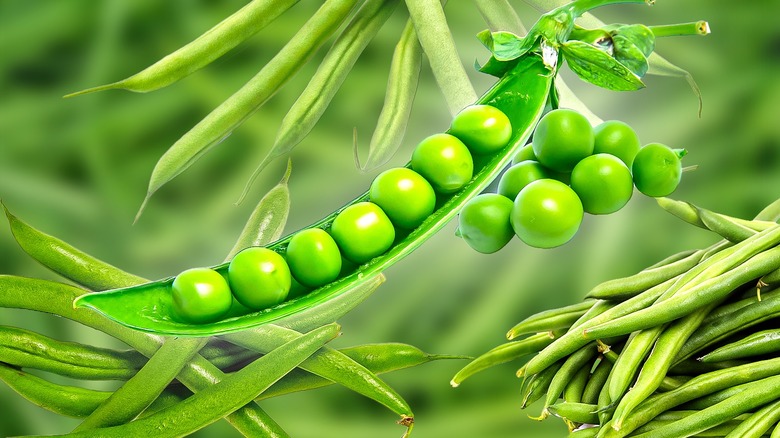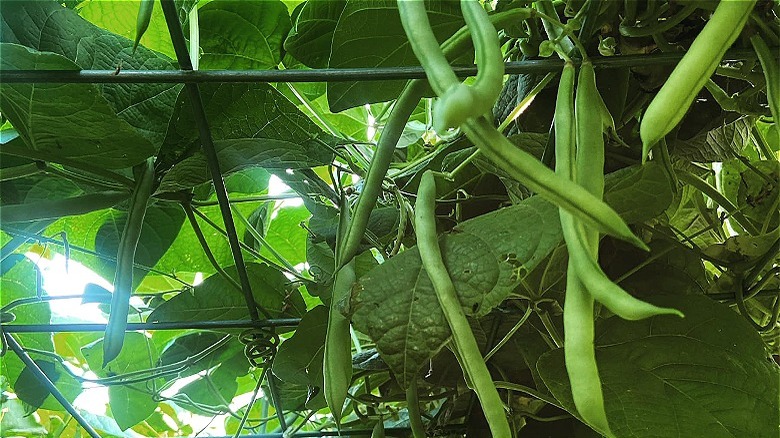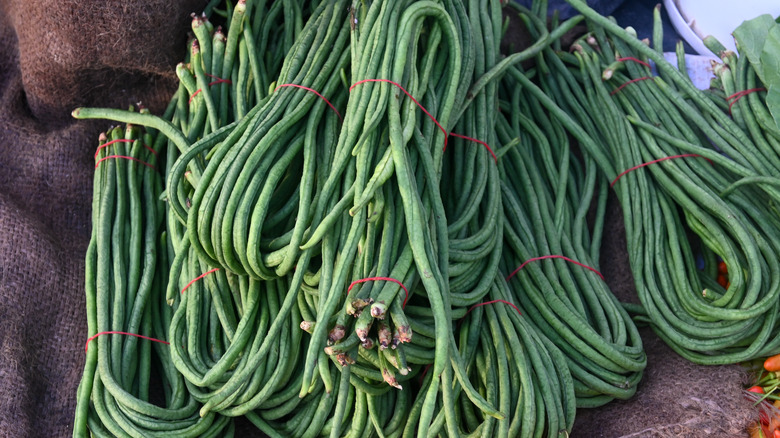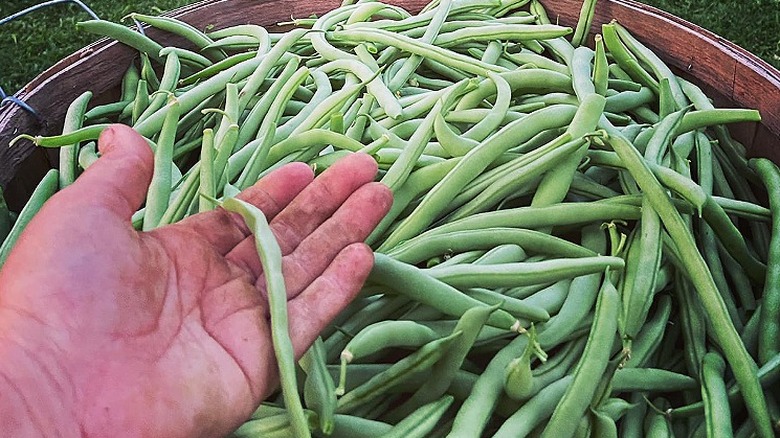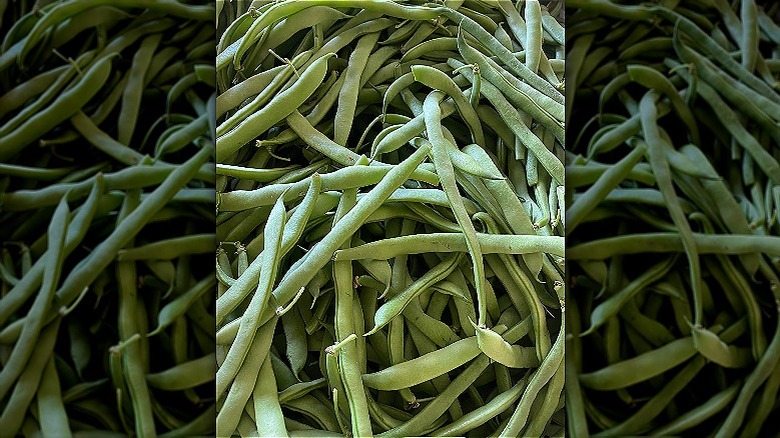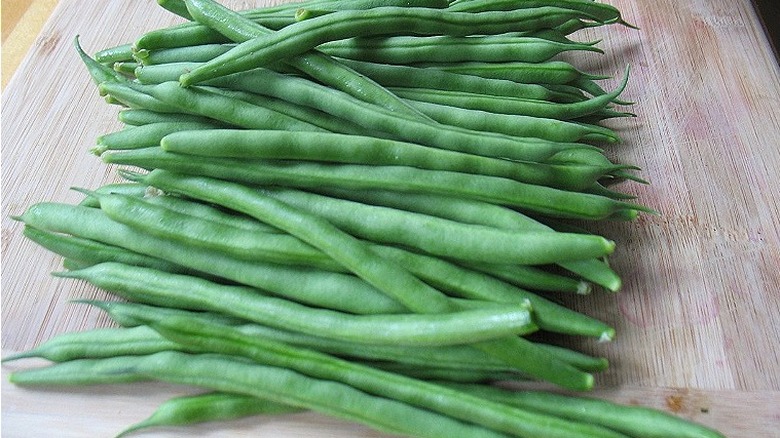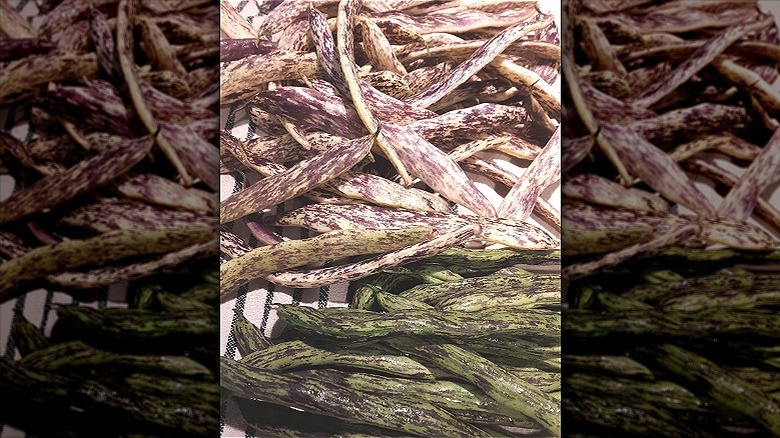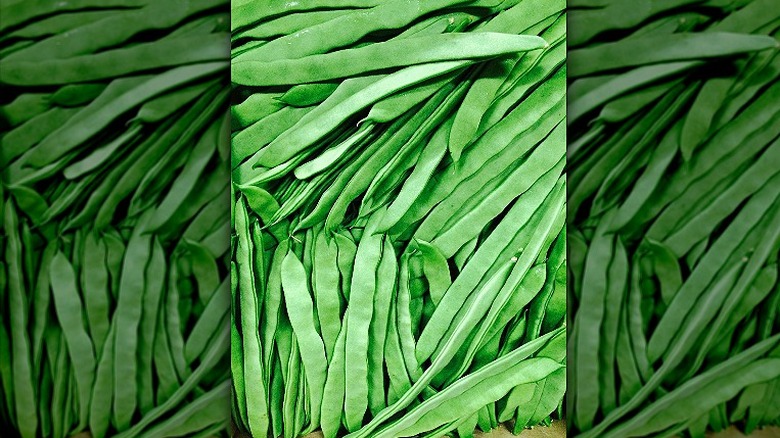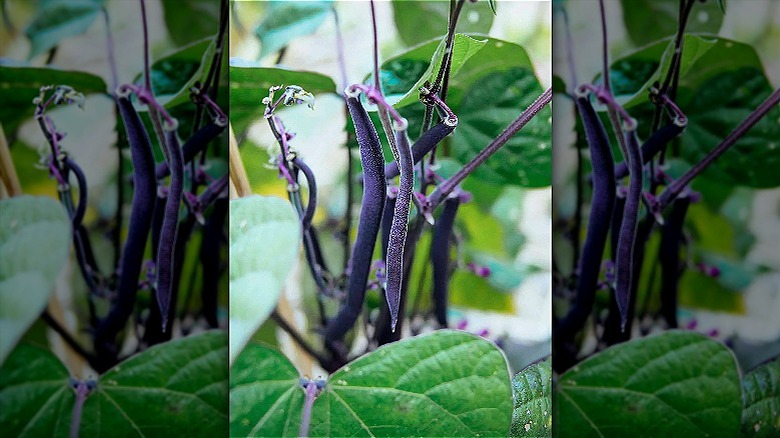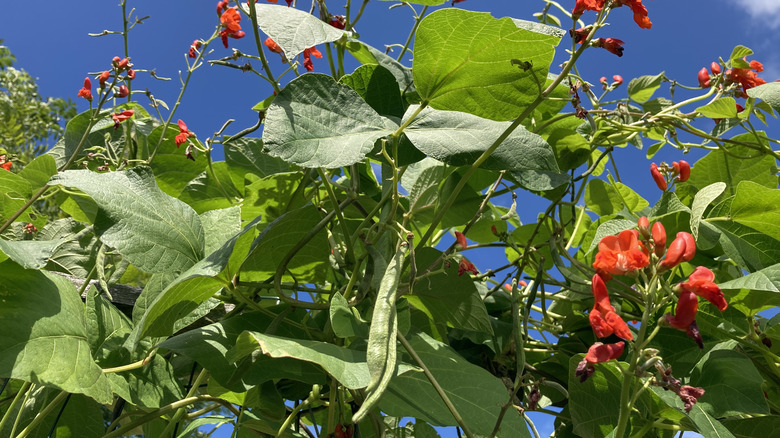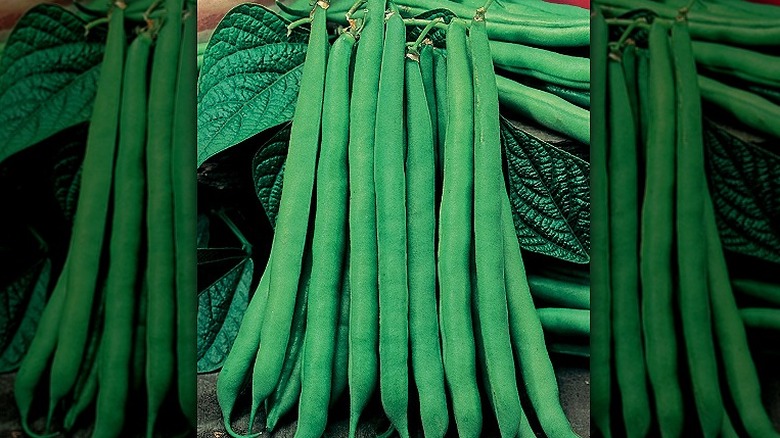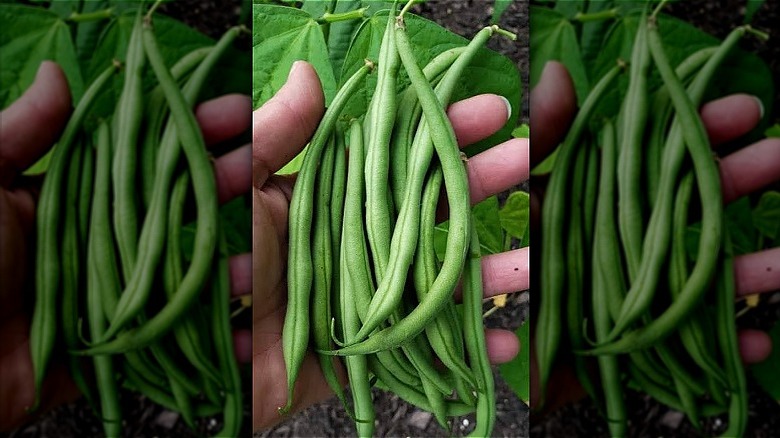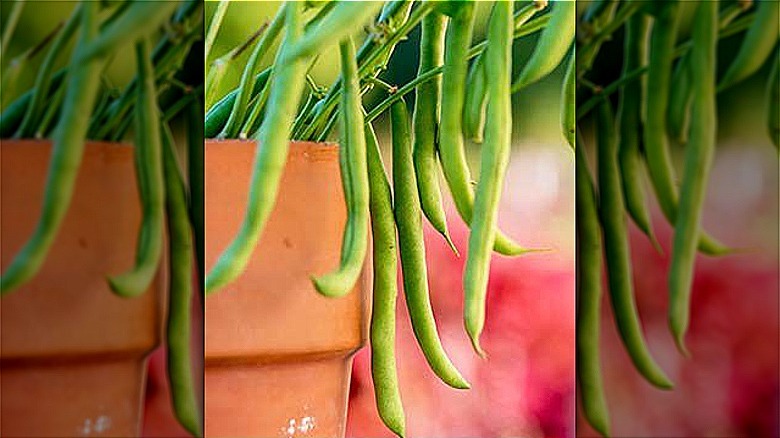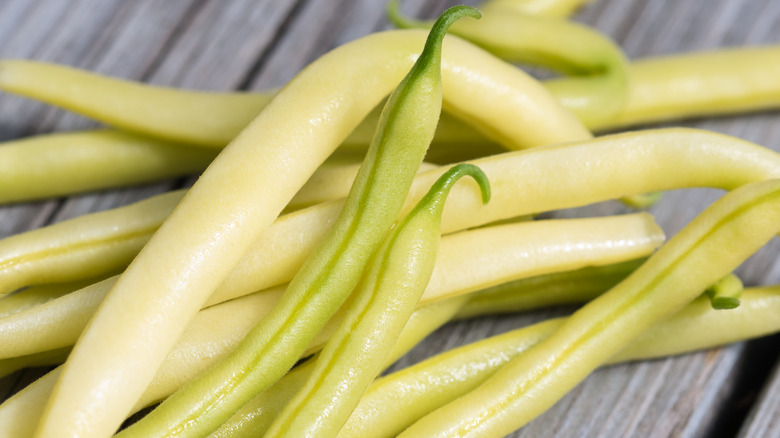14 Types Of Green Beans You Should Get Familiar With
When many of us think of green beans, the famous Thanksgiving green bean casserole comes to mind. While this is a delicious use for the green bean, it by no means represents the variety and history of this vegetable. Originating in the Andes mountains of South America, green beans didn't become a part of the diets of the rest of the world until Christopher Columbus brought them back to Europe after his second excursion to the New World in 1493. From there, new variations were cultivated and spread across the globe.
There are now over 500 varieties of green beans in existence, with names including string beans, snap beans, French beans, and haricots verts. Green beans can get divided into two basic types: bush beans and pole beans. As the name suggests, bush beans grow on short stubby bushes approximately 2 feet tall. Pole beans are more like a vine, growing up a trellis or other structure. These beans can reach heights ranging from 6 feet to 12 feet.
While green beans are nutritional powerhouses, containing fiber, protein, vitamins, and minerals, they are also incredibly versatile and delicious when cooked properly. Sautéed, stir-fried, steamed, blanched, or roasted, no matter how you opt to cook them, you'll want to keep an eye out for the various types of green beans you might find at farmer's markets or specialty grocery stores that each have slightly different flavor profiles and textures, providing you with almost endless possibilities for a nutritious and delicious vegetable to eat.
Blue Lake
When discussing different varieties of green beans, one must begin with the heirloom variety known as the Blue Lake green bean. This stringless green bean was cultivated in the early 1900s in the Blue Lake District of California, after which it got named. This variety of green beans is so well loved and coveted because it is both a bush bean and a pole bean, making it suitable to grow in various settings and climates and for myriad applications.
The beans themselves tend to grow consistently and can get harvested all at once for use. They average from 5 to 7 inches long, are generally symmetrical, and have narrowed tips. These beans are smooth, have a bright verdant hue, have a nice crispness, and are juicy. While they can get consumed raw, they are more typically cooked, which helps to tame their earthy flavor and convert their natural sugars into a nutty, caramelized flavor.
While these beans originally got developed for canning, they are now a favorite for virtually any green bean recipe thanks to their uniformity in size and texture. They would be ideal for the classic green bean casserole, although when blanched or lightly steamed, these beans are perfect for salads, retaining a firm texture without becoming mushy. These are also the perfect green bean for pickling. If you intend to store them, do not wash them. Washing can render them moldy in the refrigerator.
Long Beans
Also known as an Asparagus bean, Snake bean, Yardlong bean, and Long-Podded cowpea, the long bean often gets compared to and included in discussions about green beans, even though they belong to a different genus. More closely related to the cowpea, the long bean is similar to pole beans in that they tend to grow on vines. Unlike most green beans, the long bean is native to southern Asia. It is distinctly suited to hot climates and drought resistant, making it ideal for the unique topography of the countries in that region.
When harvested at their peak ripeness, these beans can reach 12 to 18 inches long, hence their name. They are delicate, sweet, juicy, and have a lime green hue. If allowed to grow to full maturity, they can get dense and chewy, although their seed pods can be harvested and cooked similarly to black-eyed peas. They are high in protein, making them an ideal food source for vegetarians, vegans, or populations that may not have access to a steady supply of meat protein.
These beans are less suited to applications where they get steamed, boiled, or otherwise cooked for too long a period in liquid as they can become soggy. They are ideally suited for quick stir-fries, pickling, grilling, and raw in salads. They are also delectable in curries and noodle dishes. Long beans tend to go bad faster than traditional green beans, getting mealy and floppy within three days in the refrigerator.
Contender
The Contender is a green bean variety introduced to gardens in 1949. It was adapted to be a high-yielding plant that could thrive in areas with short growing seasons because the beans mature within 50 days to full size. These are stringless bush beans, which favor warmer temperatures with direct sunlight and can be drought and disease resistant. The mature beans typically range from 6 to 8 inches long but are ideal when smaller sizes for more tender beans. Their color is bright chartreuse with smooth, even skin. While they can be suited for snapping and using in recipes fresh when harvested, they first got developed as canning and freezing beans.
Because of their firm texture when ripe, green beans are excellent freezing vegetables if you follow the proper procedures. Once picked, fresh beans should have their stem ends trimmed off. Then the beans should get blanched and shocked in ice water to maintain the best color and an al dente texture. Drain the beans thoroughly before placing them into a freezer bag. Be sure to remove as much air from the bags as possible before placing the beans into the back of the freezer to minimize temperature changes that might partly thaw the beans. Green beans can get kept in the freezer for up to 12 months before use. You can use frozen green beans straight from the freezer, particularly in soups, stews, and curries.
Kentucky Wonder
The Kentucky Wonder is an heirloom green bean dating back to the mid-1800s. It is a stringless pole bean known for being highly rust-resistant, fruitful, and adaptable. Once the final frost of the season has passed, these plants will reach maturity within 70 days, after which they can continue to get harvested over and over again. Because they grow tall, not broad, they don't take up a lot of space in your garden. They are also highly tolerant of various climates, making them suitable for several growing zones.
The beans themselves get celebrated for their distinctly large size. They can easily top 8 or 9 inches in length with a uniform width and a hunter-green color, making them a beautiful bean to use in virtually any recipe, from casseroles and stews to soups and salads. They are firm and have brown seed pods which can get shelled and eaten like a pinto bean. They also make great pickling beans or beans for battering and frying. Perhaps our favorite recipe to prepare with this bean is a classic green bean almondine. The nutty almonds are a great contrast to the bright flavor of this particular variety of green beans.
Kentucky Blue
The Kentucky Blue green bean is a hybrid variety of stringless pole beans developed by Dr. Calvin Lamborn, a Utah native considered the father of the first snap pea seed. In developing this hybrid, Lamborn married a Kentucky Wonder bean with a classic Blue Lake bean, creating a new variety that adopted the best of both. It was so successful that it won the All-American Selections Award in 1991, honoring it as an outstanding edible seed bred for superior garden performance.
This green bean gets its name for its color, which has a jade hue. It is sweeter than other pole beans and has a long pod ranging from 6 to 7 inches. It has a more substantial girth than many green bean types and is slightly more bent in shape. Its texture is beefy yet juicy, and like the Kentucky Wonder, this plant is hardy and highly fruitful. The plant should yield its first crop within 60-70 days of planting and will continue reproducing as long as the beans get harvested.
Kentucky Blue beans are uniquely well suited to a classic three-bean salad owing to their color and texture. Be sure to blanch the green beans before adding them to the salad, as most three-bean salads call for canned beans. We recommend garnishing your salad with crumbled bacon bits and feta cheese for extra umami flavor.
Rattlesnake
Rattlesnake beans are pole beans grown in North America for around 10,000 years by indigenous tribes. The Hopi tribe attributes the prolific nature of this bean to the fertility god Kokopelli, while the Cherokee Nation continues to include its seeds within its Seed Bank. Sometimes known as a "preacher bean," for inspiring religious leaders to devote sermons to it on gratitude and the value of hard work, the name of this bean has several theories. Some believe that its variegated pod looks like a rattlesnake. Others think the dehydrated seeds within the pod make a rattling sound similar to a rattlesnake. Still, others suggest the vines of this bean look like snakes climbing up their trellis as they grow to an astounding 10 feet tall.
The fresh pods average 6 to 7 inches and have purple and brown spots dotting their undulating body. The interior seeds are soft and white, becoming harder and brown as the beans mature. The fresh bean pods are sweeter and slightly more fruit-forward than other green beans. They also develop a caramelized nutty flavor when cooked. They take longer to cook than most varieties of green beans due to their slightly thick skin. They also lose their spots once cooked. The shelled dried seed pods have a rich texture and nuttiness like a pinto bean. These can get cooked like other dried beans in chili, soup, or stew. They also shine with corn in succotash or with olives for a play on a tapenade.
Romano
As their moniker indicates, Romano beans, also known as Italian Flat, Italian Pole, or fagioli a Corallo, are a green bean variety that evolved in Italy. This pole bean has an unusually flat shape looking like it has been popped through a pasta machine and extruded. They can come in colors ranging from green to yellow to purple and average about 5 inches long. They are stringless beans containing diminutive whitish green seeds. They have a spectacular snappy texture with toothsome flesh that is delicious raw or cooked.
This bean variety is ideally suited for the moderate climate of the Mediterranean. They have a long growing season, capable of producing even past the first frost, but require warmth to germinate. Once they get going, they will keep growing through extremes in temperatures and are drought and pest-resistant.
While this bean type can get cooked, experts warn not to overcook them as they tend to develop a sliminess reminiscent of okra. They are commonly pickled, added to cruidité platters and salads, and used as garnishes for savory cocktails, like a spicy Bloody Mary. Italians often add them to stews and Minestrone recipes, although they are receptive to potent Asian flavors, such as miso, soy, ginger, and lemongrass. And because of their flat shape, they are perfect for grilling, which intensifies their nutty flavor.
Royal Burgundy
Royal Burgundy green beans are an heirloom variety of stringless bush bean that has a plant that typically grows to about 20 inches in height. This particular bean is well-suited to planting in containers, making it edible and ornamental thanks to its lovely violet color. The beans mature in about 55 days, after which they can continue getting harvested until the end of the season. They are exceptionally hardy and pest resistant, making them suitable for a myriad of growing regions.
The beans themselves are 5 to 6 inches long with a texture and flavor similar to a Blue Lake green bean. Their seeds are tan colored and slightly mealy, meaning that while this variety of bean can get eaten raw or cooked, it tends to be best in raw format or lightly cooked to avoid getting slimy. Not overcooking them or serving them raw, such as pickled, also prevents the beans from losing their vibrant aubergine hue.
Like other purple vegetables, purple green beans are loaded with water-soluble pigments called anthocyanins. Anthocyanins can be acylated or non-acylated. Those that are acylated tend to be less susceptible to heat, maintaining their color, which is why purple potatoes often stay purple when cooked. Non-acylated anthocyanins are highly susceptible to heat, resulting in leaching, which ends up leaving purple vegetables green after being cooked. Blanching, stir-frying, or grilling can help minimize the loss of those purple-producing anthocyanins. Doing so will also retain the anti-inflammatory health benefits of consuming anthocyanins.
Scarlet Runner
The Scarlet Runner is a pole bean originating in Mexico and Central America. This bean was often planted as a nitrogen-rich fertilizer by indigenous cultures to grow alongside the "three sisters" — corn, beans, and squash — where the beans could climb the stalks of the corn. Once these beans reached Europe in the 1600s, they became popular food sources, with seed pods reaching up to one foot long and containing variegated seeds one inch long. Today the plant can get grown for ornamental or culinary purposes, although it most frequently gets planted on trellises, where its crimson flowers attract hummingbirds.
This plant can get eaten at virtually every stage of its development. Its bright flowers are delightful to add to salads. Its pods can be dense and woody, making them difficult to digest unless thoroughly cooked. Due to their large size, their pods tend to get sliced before cooking in stews, soups, or curries. The large seeds within these pods are the true star of this plant. When fresh, they can get used as a substitute for lima beans in salads, sautées, or stir-fries. As they dry out, they take on beautiful colors in hues of white to deep mahogany with speckles of red. Their flavor is redolent of chestnuts when cooked, though they require some patience to process, as they need extensive soaking and cooking to be tender enough to eat. They are common in bean soups and chili and may even get made into hummus.
Tendergreen
The Tendergreen, or Tendergreen Improved, is advertised as one of the simplest-to-grow green bean varieties for beginning gardeners or perhaps gardeners with black thumbs like us. They are resilient, can grow in diverse climates, are disease resistant, and naturally fight off pests. They also do not require a lot of water or attention. This bush bean type is ready for harvest within 55-60 days and tends to be an abundant producer. As advertised, their bean pods, which are approximately 5 to 6 inches long at harvest, are — tender and slender. They are sweet, nutty, and not overly vegetable-forward, making them suitable for those who tend to be less fond of vegetables.
As with other green beans, these beans are ideal both raw and cooked, although their uniquely succulent texture makes them delightful to munch on with dips without any preparation. They can create a stellar green bean casserole, are splendid in Asian stir-fries, and are ideal for sautéeing. Just be careful not to overcook them, as they won't retain that al dente texture that makes them so appealing. These are perfect green beans to toss into your air fryer to convert into a version of a green bean chip your kids will gobble up as an after-school snack.
Maxibel
The Maxibel Haricot Vert is a bush bean considered the premier "French filet" bean. Filet beans are known for their slender pods that are exceedingly delicate in texture and flavor. While they can range in color from verdant to golden to violet, this particular variety is a beryl hue. The pods tend to be ready to harvest in 60 days and will be about 7 inches long when ripe. These beans should get harvested while young to maximize their flavor, making them labor-intensive for a short period. Due to their short growing season, they can thrive virtually anywhere with adequate sun and moderate moisture.
These beans are ideal for classic French green bean dishes, such as Haricots Verts Amandine, Poêlée de Radis et Haricots Verts, or Salade Niçoise. In our experience, these beans also don't have a long shelf life. They should get eaten, frozen, canned, or pickled within a day or two of harvesting for the best quality before beginning to break down and get mealy.
Porch Pick
For those who don't have much gardening space or live in an apartment with a small porch or balcony, the Porch Pick bean is the variety designed for you. This small bush bean plant is ideal for planting in a pot to brighten your porch and provide a bumper crop of edible green beans. This bean variety tends to be a bit precious, requiring direct sunlight, consistent watering equivalent to one inch of rainfall weekly, must be harvested regularly to prevent the beans from overwhelming the plant, and can be somewhat susceptible to diseases and pests.
The bean pods, which are usually ready for harvest in 55 days, average about 5 inches long, are crunchy and have a light grassy color. They can get used in any capacity as other green bean varieties but will shine in salads and side dishes when blanched. Depending upon the size of your kitchen and how many people you are feeding, you may find the yield of this plant slightly higher than what a single person or couple can consume. Pickled green beans make a fabulous homemade gift for friends and family.
Wax Beans
No discussion of green beans would be complete without talking about the elephant in the room — wax beans. These yellow beans are identical to green beans in every capacity except that they lack chlorophyll, giving them a muted canary hue rather than a verdant one. This type of bean is the earliest known cultivar, spreading from Algeria throughout Europe, where varieties like the famed Beurre De Rocquencourt Bush Wax bean evolved in Rocquencourt, France.
These bush beans are stringless and get their name from the matte texture of the bean pods, which tend to have a mild, sweet, nut-forward flavor. Because they lack chlorophyll, they tend to be slightly more challenging to grow. They are highly susceptible to pests and can spread quickly, making a trellis of some sort desirable to contain its leaves. They also require abundant sunlight.
Because of their distinctly creamy texture when cooked, wax beans pair beautifully with pork fat, butter, cream sauces, and shellfish. They are also a common ingredient in a classic Hungarian soup dish that we happened to grow up eating. The bright red paprika and unctuous sour cream juxtapose these beans beautifully. They are also a great alternative to green beans in a classic Thanksgiving casserole, as their nuttiness bounces off the cream of mushroom soup, providing a velvety mouthfeel.
